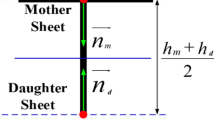Abstract
Due to the discreteness of material variables and nonlinearity of material plastic segment, the material-structure matching design efficiency of multiple parts is very low, and it is even difficult to achieve a feasible solution. To solve these problems, a performance-driven lightweight optimization method that combines multi-material selection method and multi-objective optimization is proposed. First, a lightweight multi-material selection method for the cab is proposed, which integrates static stiffness constraint, equivalent crashworthiness, and evaluation method for material selection. Subsequently, the multi-material selection designs for the skeleton beam of cab are carried out. The results show that the material selection scheme achieved a mass reduction of 12.41 kg and material cost reduction of 0.861 yuan. Finally, a multi-objective optimization method incorporating TOPSIS method is used to solve material-structure coupling design. The results show that the mass of cab is reduced by 47.4 kg. The performance of cab are slightly changed, indicating the rationality of the lightweight design method.


























Similar content being viewed by others
References
Alexander JM (1960) An approximate analysis of the collapse of thin cylindrical shells under axial loading. Q J Mech Appl Math 13:10–15
Ashby M (2000) Multi-objective optimization in material design and selection. Acta Mater 48:359–369
Cui A, Wang D, Chen H, Rong A, Zeng Q, Bu S (2010) Cab structural optimization of a commercial vehicle based on modal sensitivity analysis. Automot Eng 6:535–539
Cui X, Zhang H, Wang S, Zhang L, Ko J (2011) Design of lightweight multi-material automotive bodies using new material performance indices of thin-walled beams for the material selection with crashworthiness consideration. Mater Des 32:815–821
Edwards KL (2004) Strategic substitution of new materials for old: applications in automotive product development. Mater Des 25:529–533
Hahn O, Kurzok JR, Timmermann R (2001) Joining of multi material constructions. In: Chinese-German ultralight symposium, Bei**g
Hallquist JO (2007) LS-DYNA keyword user’s manual. Livermore Softw Technol Corp 970:299–800
Hanssen AG, Langseth M, Hopperstad OS (2000) Static and dynamic crushing of square aluminium extrusions with aluminium foam filler. Int J Impact Eng 24:347–383
Johnson GR, Cook WH (1985) Fracture characteristics of three metals subjected to various strains, strain rates, temperatures and pressures. Eng Fract Mech 21:31–48
Khalkhali A, Mostafapour M, Tabatabaie SM, Ansari B (2016) Multi-objective crashworthiness optimization of perforated square tubes using modified NSGAII and MOPSO. Struct Multidisc Optim 54:45–61
Koo J, Cho H (2009) Theoretical method for predicting the weight reduction rate of a box-type car body for rolling stock by material substitution design. Int J Automot Technol 10:355–363
Li S, Bai JT, Wang XC, Song LM, Luo K, Zuo WJ (2020) Equivalent substitution criteria of aluminum for steel and its application in automobile structures. Adv Mech Eng 12:17
Mamalis AG, Manolakos DE, Ioannidis MB, Kostazos PK (2006) Bending of cylindrical steel tubes: numerical modelling. Int J Crashworthiness 11:37–47
Shojaeefard MH, Khalkhali A, Firouzgan A (2016) Multi-objective optimization of a natural aspirated three-cylinder spark ignition engine using modified non-dominated sorting genetic algorithm and multicriteria decision making. J Renew Sustain Energy 8:025705
Wang S, Wang DF (2021) Crashworthiness-based multi-objective integrated optimization of electric vehicle chassis frame. Arch Civil Mech Eng 21:103
Wang D, Wang S, **e C (2019) A multi-objective optimization approach for simultaneously lightweighting and maximizing functional performance of vehicle body structure. Proc Inst Mech Eng D 234(7):2086–2102
Wang D, **e C, Liu Y, Xu W, Chen Q (2020) Multi-objective collaborative optimization for the lightweight design of an electric bus body frame. Automot Innov 3:250–259
Wang DF, **e C, Wang Y (2021) Multi-objective lightweight and crashworthiness collaborative optimisation of commercial vehicle cab. Int J Crashworth 15:1017–1031
Wierzbicki T, Abramowicz W (1983) On the crushing mechanics of thin-walled structures. J Appl Mech 50:724–734
**e C, Wang DF (2020) Multi-objective cross-sectional shape and size optimization of S-rail using hybrid multi-criteria decision-making method. Struct Multidisc Optim 16:3477–3492
Zhang J-Y, Chen G, Wu L-N, Liu Y (2013) Lightweight method of car’s front rails based on the theory of thin-walled beam crashworthiness. Jilin Daxue Xuebao (Gongxueban) 43:1441–1446
Zhang HH, Peng Y, Hou L, Tian GD, Li ZW (2019) A hybrid multi-objective optimization approach for energy-absorbing structures in train collisions. Inf Sci 481:491–506
Funding
This work was supported by the National Key Research and Development project of China (Number 2022YFB2503501), National Natural Science Foundation of China (Grant Number 51975244), and Graduate Innovation Fund of Jilin University (Number 101832020CX131).
Author information
Authors and Affiliations
Corresponding author
Additional information
Responsible Editor: Palaniappan Ramu
Publisher's Note
Springer Nature remains neutral with regard to jurisdictional claims in published maps and institutional affiliations.
Rights and permissions
Springer Nature or its licensor (e.g. a society or other partner) holds exclusive rights to this article under a publishing agreement with the author(s) or other rightsholder(s); author self-archiving of the accepted manuscript version of this article is solely governed by the terms of such publishing agreement and applicable law.
About this article
Cite this article
**e, C., Wang, D., Wang, S. et al. A performance-driven lightweight optimization method for material-structure coupling design of cab. Struct Multidisc Optim 67, 12 (2024). https://doi.org/10.1007/s00158-023-03730-6
Received:
Revised:
Accepted:
Published:
DOI: https://doi.org/10.1007/s00158-023-03730-6




